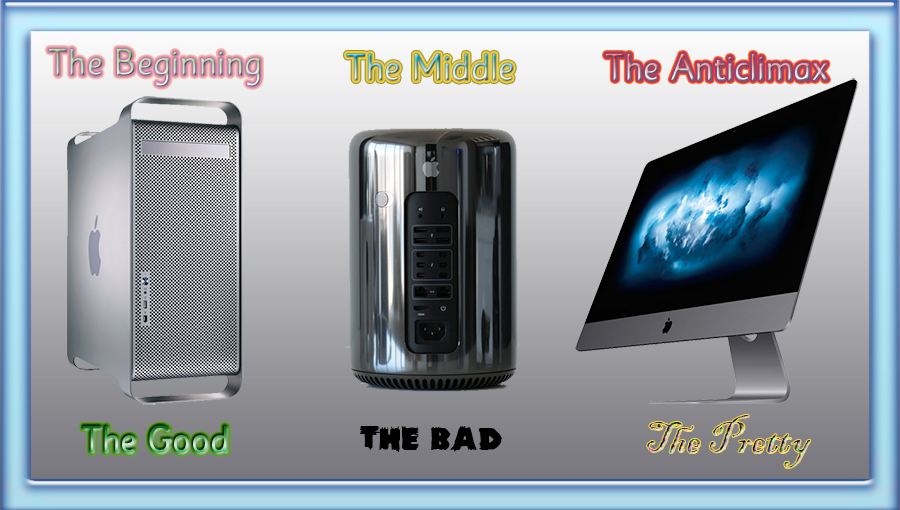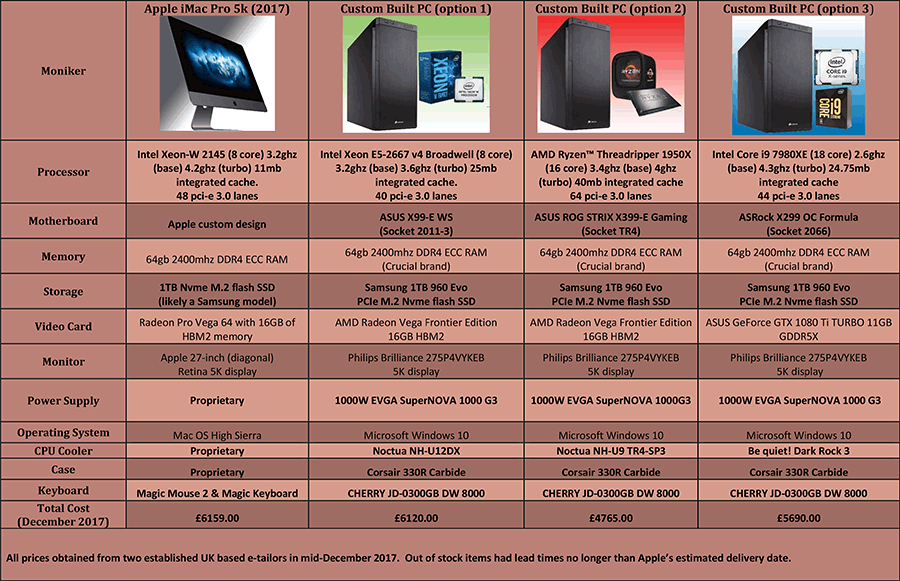Minimised to the Macs!
Minimised to the Macs
“Oh! What a machine.”
“The pros really seem to like it.”
“It’s not up-gradable.”
“Uh. The ram is but you have to take it to a service centre in order for them to do it for you.”
The above four statements were uttered by two prolific and venerable technology journalists during the winter of 2017 and related to a product whose i-conic forger had, for the very first time in five minutes accomplished the remarkable feat of combining the visually stunning with the practically stunted.
With such ubiquitous terms as “service centre” and unsubtle allusions as i-conic, one surely wouldn’t need four guesses to identify either the forger in question or “its” bittersweet creation.
I am referring of course to the ingeniously christened iMac Pro , a welcome return to moniker minimalism for our Golden delicious demagogue and an augmented descendant of a machine which first materialised in late 2014 and bore the rather more descriptive name “iMac with 5K retina Display brackets twenty seven inches”.
Exactly one year later, this cosmetically enchanting innovation, marred only by its tendencies to overheat, throttle and sound like of swarm of raging wasps whenever customers committed the heinous crime of using it as advertised, was succeeded by a thermally tempered sibling that flaunted a faster video card and a processor two eras younger.
Two further journeys around our solar enabler and this too was supplanted by a third incarnation armed with ever greater pixel and number crunching credentials but a somewhat simplified Avatar, the “Twenty Seven Dash Inch iMac”, no more flagging up the five K display since following three years of feverish promotion, Apple had evidently concluded that its fantastically astute disciples would take this generous feature for granted. Therein lies the key word, generous.
Delving back into dim and distant history, when our Golden delicious demagogue was able to sequester its desktop destined silicon from the frigidity fingers of keen enthusiasts, it was difficult to assert that, say, a flagship G5 endowed with a dash of Power PC’s RISCy business represented anything but fantastic value for its target niche. Not even a knowledgeable custom builder could visit their favourite e-tailer, populate a virtual trolley with identical components and cultivate their very own forbidden fruit, or as it later became known, Hackintosh.
However, once Apple’s concerns over carbon consumption had forced them to abandon Power PC and forge a truce with hitherto arch rival, Baron Von Intel, no amount of smoke or mirrors could foil the savvy. Intel’s redoubtable works of art had been readily available off the shelf for almost two decades and their bounties known throughout communities of technophiles seeking bespoke perfection or casual hobbyists constructing workhorses to flog on auction sites. Neither faction wasted any time in highlighting the price chasms between their personal creations and identically appointed Macbooks, iMacs or Mac Pros configured using Apple’s dummy proof part picker. The New World Orchard’s staunchest devotees asserted that a cocktail of captivating cosmetics, a surgically streamlined OS and kindly souls in blue T-shrts to provide counselling when your Processor melts, entirely justified the modest surcharge, or as they called it, donation.
Social media’s exponential evolution soon provided a variety of lucrative platforms for incensed fanboys to preach what had previously been viewed as puerile forum patter and splinter groups of artistic Appolytes began to express their longing for a system that permitted the merest hint of post-purchase expand-ability and question whether formerly feature-rich applications were gradually devolving into bowdlerised consumerist parodies more lacking in practical functions than rose gold compost, Apple responded in typically shameless style and delivered to its detractors a showcase of self-righteous materialism, the least upgrade-able iMac in the world, ever. It was sour pips, even for the most profligate MACioso to know that clicking the buy button for anywhere between five and ten thousand dollars would acquire them a computer utterly devoid of user install-able upgrades and sealed tighter than a Martian space craft.

Nevertheless, unconditional apple-ologosts were adamant that such sacrifices were trivial in return for aesthetic perfection and software better tailored than a saville row suit and moreover, that it was impossible to construct a cheaper part for part clone since the components within the iMac pro were a cut above the conventional top tier.
In truth, the processor oscillating at the heart of this slender pretender was one in a platoon of twelve Skylake based Xeon “W” chips, deployed by Intel in the high summer of 2017 to relieve its four generation old E5-1600 series, itself a single socket alternative to the pricier 2600.
When compared to their master’s more roundly publicised core i9 family, forged in the same season, Xeon Ws boasted three notable advantages, namely their ability to run ECC memory modules, address up to 512GB of total RAM and provide an additional 4 pci-e lanes to bandwidth gorging peripherals, most likely multiple video cards in running in Crossfire or SLI .
The first of these benefits would have indeed been essential for anyone intent on using their iMac Pro to run mission critical applications with zero tolerance for single or multi-bit errors which, under normal circumstances, would pass silently through the system’s memory potentially resulting in the pernicious corruption of pivotal data, such as that generated for the purposes of medical or mathematical research. To an aspiring iMac pro owner, projects of this nature were as interesting as a prime numbers festival, though anything that sounded like it could rationalise their relentless desire for the prohibitive and the pointless was seized upon instantaneously.
As to the other merits, both were wholly redundant since the iMac pro only supported a maximum of 128GB and was unable accommodate or utilise more than one GPU, other than if added externally and enlisted for strictly non-crossfire duties. In other words, all work and no play.
“But what pulp head would buy an iMac pro for gaming?” Cried the die-hard Appalachians.
These machines are precision instruments conditioned for the cutting edge of digital production and compelled to serve only those seeking the fullest content, the finest quality and the fastest workflow.
Radical entrepreneurs or self-styled media moguls with no time to fritter on childish hobbies as they gracefully artfully scale the summit of cyber media.
Prolific professionals whose ambitious projects demand a transcendental standard of presentation. Vloggers, photographers, journalists and technophiles, all tirelessly engaged in composing masterclasses of sonic splendour and visual panache guaranteed to astound their enchanted audience with such dazzling techniques as no silence whatsoever, a hundred jump cuts in fifty seconds synchronised to fragments of tacky library music amplified to a thousand decibels, fantastically complicated close-ups of grass, groceries, sign posts and grinning faces not forgetting the old camera that this new camera is replacing for the three months that it takes for a newer one to emerge and at least one utterance of the rhetorical phrase “What is up guys”, followed by a grossly skewed opinion of whether or not you can “Game on an iMac Pro.
Savage sarcasm aside, there was little doubt that this decidedly cruiser-weight workstation was a canny ploy by Apple to entice those with vanilla iMacs to squander thousands more on what amounted to bigger cone and chocolate sprinkles but no option of a double scoop and coerce others desperate to demote their once gleaming garbage cans to invest in what they’d hoped would be the next fully modular Mac Pro before investing again in a matter of months in the next fully modular Mac Pro.
Now, time to feast you eyes on some refreshing factual fortitude. A table populated with some attractive alternatives to our clad charlatan, all of them cheaper, markedly more versatile and able to bond with their proud adopters in a far more meaningful fashion.

Parting Pontifications
For the price of an 8 core iMac with 64gb ram, 1tb storage and a 16gb Vega Pro You could spec a Core i9 7980XE or 1950X Threadripper based system (including a Vega FE 16GB card and a 5K display) for 650 or 1800 dollars less respectively.
Both of the latter CPUs would comprehensively decimate the Xeon 2145 chip in the iMac and would only be rivalled by its 14 and 18 core variants which would have set you back a further 2000 or 2500 dollars. Moreover, both of these options would be fully upgradeable with additional, RAM, GPUs and storage space at any time and even better, the display isn’t inextricably tied to one system.
Graphics card can be upgraded with a choice of AMD or Nvidia.
A second, third or fourth GPU can be added for significant performance increases whether for video eidting and encoding, gaming, 3d rendering, deep learning or any appcation that places intensive workloads on the graphics subsystem.
Additional RAM can easily installed if or when required.
Further peripherals such as a sound card, high speed network adaptor or NVME RAID controller can be added as and when the budget allows
Storage capacity can be upgraded at any time either via onboard M.2, U.2 or SATA ports depending on preference.
Monitor has multiple inputs and can be used with other systems or shared between them.




